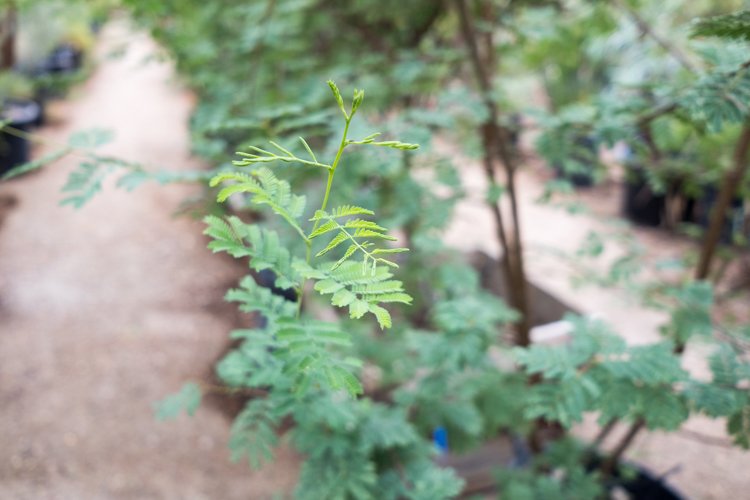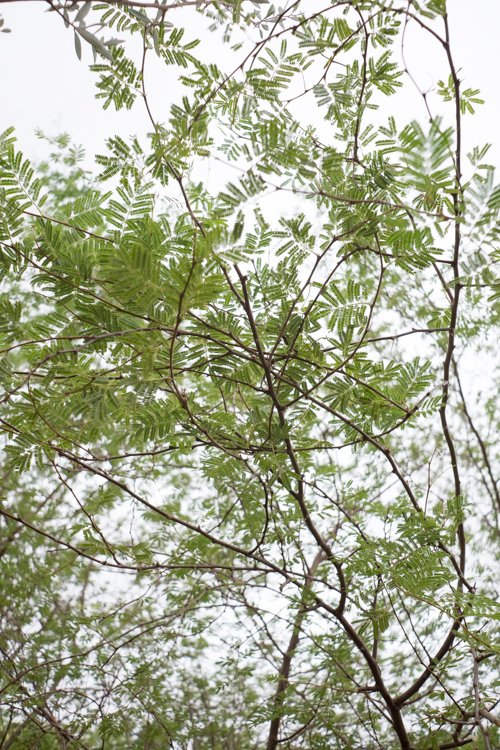Sweet Acacia Tree
Sweet acacia tree for sale at the nursery
The Sweet acacia tree is one delightful fragrant desert tree.
Enjoy its very long, blooming season! Sweet acacia will reward you with a sweet honey-like fragrance from fall to spring.
Finally, it takes the grueling desert conditions like a champ, requiring minimal water once mature, and resisting triple-digit heat, even in the full sun.
Botanical name: Vachellia farnesiana
Other names: Acacia farnesiana (previous botanical name), Mimosa farnesiana (previous botanical name), Huisache
TABLE OF CONTENTS
Sweet Acacia Appearance
Sweet acacia is small to a medium-sized drought-tolerant tree that reaches 15-25 feet in height with a 15 feet spread.
The dense canopy of leaves that are evergreen in areas with mild winters, such as the Coachella Valley. Deciduous in areas with cold winters. Tiny, green leaflets that are long and oval grow in pairs, forming a larger "leaf" that looks like a feather.
Young branches are green and have numerous sharp thorns. More mature branches are gray and have fewer thorns.
Long bloom season from fall to spring. Showy flowers are bright yellow and look like puff balls—very pleasant and strong aroma.
Sweet acacia is in the pea family. After the bloom, tiny, green seedpods will emerge, after which will turn into a darker color.
Sweet Acacia Landscaping Tips
Sweet acacia is one of the most fragrant heat and drought-tolerant trees. Flowers are used for making perfumes.
It makes an excellent shade tree that allows some filtered light through. It can be used to protect smaller shrubs that cannot take the direct full sun in the desert.
Pest resistant.
Adds bright color to the garden from fall to spring with its cheery, yellow flowers. Attracts pollinators such as butterflies and bees.
Sweet acacia trees are somewhat messy when they fruit, creating a litter of seed pods.
Handle with caution. Thorns are very sharp.
It can be a large shrub if left untouched. To have a tree-like appearance, prune younger trees to develop a single trunk. We recommend doing the heavy pruning in spring in the Palm Springs region. Less pruning is required once mature.
A fast-growing tree, growing at 3 feet a year given favorable conditions.
Sweet Acacia Origin
Sweet acacia is from desert regions in the Southwest, USA and Mexico.
Sweet Acacia Care
Soil: Loose, well draining soil that is moderately fertile.
Temperature: Can withstand temperatures down to 20 degrees for a short period of time.
Water: Drought tolerant once mature. Occasional, deep watering. For new and young trees, water more often.
Sun: Full sun
Sweet Acacia Problems
Pests: Sweet acacia has minimal pests. Fungal diseases from root rot, dry rot, and harsh weather conditions. Make sure that the Sweet acacia tree does not get overwatered.
Signs of overwatering: Drooping, squishy texture, weak branch growth, leaf drop
Signs of too little water: Leaf discoloration, leaf drop
Signs of too much sun: Burning, scarring, fading color
Signs of too little sun: Etiolation, discoloring
Sweet Acacia Propagation
Once the Sweet acacia seed pods are dark and ripe, collect the seeds and plant in moist soil.
FAQ
How much does the Sweet acacia tree cost?
At our nursery, a Sweet acacia tree costs $120 for a 15-gallon container, $250 for a 24-inch box, $500 for a 30-inch box, $750 for a 36-inch box, and $2,500 for a 48-inch box.
Prices are subject to change. Please contact us for the most up-to-date information on pricing. We may have larger sizes available. We provide installation services locally at a separate cost.
What does sweet acacia smell like?
Some say that Sweet acacia smells like sweet, woodsy and floral honey.
Is Sweet Acacia messy?
Sweet acacia trees are somewhat messy when they fruit, creating a litter of seed pods.
How fast does Sweet acacia grow?
Sweet acacias are fast-growing, often at 3 feet a year.
Summary
| SIZE (H X W) | 25 feet x 15 feet |
|---|---|
| FLOWER COLOR | Yellow |
| FLOWER SEASON | Fall to Spring |
| EXPOSURE | Full Sun |
| WATER | Low |
| GROWTH RATE | Fast |
| HARDINESS | 20º F, USDA Zone 8 |
| PRUNING | As needed |


